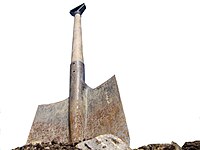| Revision as of 23:59, 6 May 2008 editNewbyguesses (talk | contribs)Extended confirmed users7,860 edits moving the image;ex nutshell;← Previous edit | Revision as of 00:35, 7 May 2008 edit undoNewbyguesses (talk | contribs)Extended confirmed users7,860 edits ceNext edit → | ||
| Line 3: | Line 3: | ||
| ] | ] | ||
| Clear thought and clear expression facilitate good editing as well as effective communication between editors. ] is |
Clear thought and clear expression facilitate good editing as well as effective communication between editors. ] is to say clearly and directly what you mean; describing something concisely and accurately. Rather than using oblique and obfuscating language, just "tell it like it is." | ||
| Calling a spade a spade requires clear observation and honest judgment. The time to call a spade a spade is after you've looked into the thing deeply enough to be sure you understand its nature; in other words, be sure the spade is a spade, before you call it a spade. Jumping to conclusions is inconsistent with what we mean by calling a spade a spade, because it can lead to misrepresenting the thing you're describing, which is contrary to the goal of accurate description. Do not be so quick to judge, that you neglect good judgment. | Calling a spade a spade requires clear observation and honest judgment. The time to call a spade a spade is after you've looked into the thing deeply enough to be sure you understand its nature; in other words, be sure the spade is a spade, before you call it a spade. Jumping to conclusions is inconsistent with what we mean by calling a spade a spade, because it can lead to misrepresenting the thing you're describing, which is contrary to the goal of accurate description. Do not be so quick to judge, that you neglect good judgment. | ||
Revision as of 00:35, 7 May 2008
Essay on editing Misplaced Pages| This is an essay. It contains the advice or opinions of one or more Misplaced Pages contributors. This page is not an encyclopedia article, nor is it one of Misplaced Pages's policies or guidelines, as it has not been thoroughly vetted by the community. Some essays represent widespread norms; others only represent minority viewpoints. | Shortcuts |

Clear thought and clear expression facilitate good editing as well as effective communication between editors. To call a spade a spade is to say clearly and directly what you mean; describing something concisely and accurately. Rather than using oblique and obfuscating language, just "tell it like it is."
Calling a spade a spade requires clear observation and honest judgment. The time to call a spade a spade is after you've looked into the thing deeply enough to be sure you understand its nature; in other words, be sure the spade is a spade, before you call it a spade. Jumping to conclusions is inconsistent with what we mean by calling a spade a spade, because it can lead to misrepresenting the thing you're describing, which is contrary to the goal of accurate description. Do not be so quick to judge, that you neglect good judgment.
The duck test
This line of thinking is sometimes referred to as the duck test: If it looks like a duck, swims like a duck and quacks like a duck, it's probably a duck.... The test implies that a person can figure out the true nature of an unknown subject by observing this subject's readily identifiable traits.
The Jack Kennedy test
This negative version of this line of thinking is sometimes referred to as "Jack Kennedy test" after the Lloyd Bentsen quote: "Senator, I served with Jack Kennedy: I knew Jack Kennedy; Jack Kennedy was a friend of mine. Senator, you're no Jack Kennedy".
See also
- Misplaced Pages:Don't call the kettle black
- Misplaced Pages:You can't squeeze blood from a turnip
- Misplaced Pages:Don't call a spade a spade